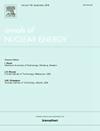A hybrid optimized Picard method for neutronic/thermal-hydraulic coupling problem
IF 1.9
3区 工程技术
Q1 NUCLEAR SCIENCE & TECHNOLOGY
引用次数: 0
Abstract
Picard iteration is a widely-used method for Neutronic/Thermal-Hydraulic (N/TH) coupling calculation in nuclear reactor, but it usually suffers from computational efficiency and stability, especially for complicated large-scale coupling issues. Residual balance method (RB) and Anderson acceleration method (AA) are two well-known optimized variants, where the former focusing on reducing the computational cost per outer iteration by adaptive tolerance, and the latter on decreasing the number of outer nonlinear iterations by using multiple iteration history information. However, combining these two methods causes incompatibility because the inaccurate function evaluations from the adaptive tolerance in the inner iterations disrupt the convergence rate of Anderson acceleration. In this work, a new hybrid optimized Picard iteration method (Picard-H) is proposed to combine the advantages of residual balance method and Anderson acceleration method by using an adaptive switching factor, avoiding the incompatibility from the inner iteration when approaching convergence. This new method could further enhance the efficiency of Anderson Acceleration, which could finish calculation much faster than both RB and Picard. A simplified neutronic k-eigenvalue problem in PWR with thermal–hydraulic feedback effect is utilized to evaluate the performance of the new optimized Picard method. The results demonstrate that for the simplified PWR model, the Picard-H method is 10% more computationally efficient than the AA method, more than twice as fast as the RB method, and more than four times faster than the traditional Picard method. In addition, the simple combination of RB and AA methods diverges due to the inexact fixed-point mapping function evaluation from the RB method. Furthermore, the hybrid method is robust against variations in parameters, such as the bounding parameter in the residual balance method and the memory depth in Anderson acceleration. The computational performance of the new method also is not sensitive to the choice of switching factor which is suggested to be adaptive when the residual drops to about 2 to 3 orders of magnitude of the initial residuals. The supplementary numerical results from the simplified HTR-10 model confirm that the Picard-H method exhibits 5% greater computational efficiency than the AA method and is over nine times faster than the traditional Picard method and the RB method.
中子/热液耦合问题的混合优化皮卡尔法
本文章由计算机程序翻译,如有差异,请以英文原文为准。
求助全文
约1分钟内获得全文
求助全文
来源期刊

Annals of Nuclear Energy
工程技术-核科学技术
CiteScore
4.30
自引率
21.10%
发文量
632
审稿时长
7.3 months
期刊介绍:
Annals of Nuclear Energy provides an international medium for the communication of original research, ideas and developments in all areas of the field of nuclear energy science and technology. Its scope embraces nuclear fuel reserves, fuel cycles and cost, materials, processing, system and component technology (fission only), design and optimization, direct conversion of nuclear energy sources, environmental control, reactor physics, heat transfer and fluid dynamics, structural analysis, fuel management, future developments, nuclear fuel and safety, nuclear aerosol, neutron physics, computer technology (both software and hardware), risk assessment, radioactive waste disposal and reactor thermal hydraulics. Papers submitted to Annals need to demonstrate a clear link to nuclear power generation/nuclear engineering. Papers which deal with pure nuclear physics, pure health physics, imaging, or attenuation and shielding properties of concretes and various geological materials are not within the scope of the journal. Also, papers that deal with policy or economics are not within the scope of the journal.
 求助内容:
求助内容: 应助结果提醒方式:
应助结果提醒方式:


